Ultraviolet-C Light Effects in Actinidia spp. Infected by Pseudomonas syringae pv. actinidiae
Abstract
:1. Introduction
2. Materials and Methods
2.1. UV-C Irradiation Equipment
2.2. Plant Material and Growing Conditions
2.3. Irradiations
2.4. Morphological Observations
2.5. Artificial Inoculation and Assessment of the Severity of Visible Symptoms
2.6. Spectrophotometric Analyses
2.6.1. Contents of Chlorophyll a and b and Carotenoids
2.6.2. TPC and AC
2.7. Statistical Analysis
3. Results
3.1. A. chinensis var. deliciosa cv. Hayward, A. chinensis var. chinensis cv. Soreli® and A. arguta In Vitro Cultured Shoots (Irradiation Dose 2.2 kJ/m2)
3.1.1. Macroscopic Morphological Response to Irradiation
3.1.2. Psa Inoculation
3.1.3. Photosynthetic Pigments, Total Phenolics Content, and Antioxidant Capacity
3.2. A. chinensis var. chinensis cv. Soreli® Potted Plants (Irradiation Dose 2.2, 1.3, 0.8, and 0.3 kJ/m2)
3.2.1. Macroscopic Morphological Response to Irradiation
3.2.2. Psa Inoculation
3.2.3. Photosynthetic Pigments, Total Polyphenols, and Antioxidant Activity
4. Discussion
5. Conclusions
Author Contributions
Funding
Data Availability Statement
Conflicts of Interest
References
- Loconsole, D.; Santamaria, P. UV Lighting in Horticulture: A Sustainable Tool for Improving Production Quality and Food Safety. Horticulturae 2021, 7, 9. [Google Scholar] [CrossRef]
- Sidibé, A.; Charles, M.T.; Lucier, J.F.; Xu, Y.; Beaulieu, C. Preharvest UV-C hormesis induces key genes associated with homeostasis, growth, and defense in lettuce inoculated with Xanthomonas campestris pv. vitians. Front. Plant Sci. 2019, 12, 793989. [Google Scholar] [CrossRef]
- Godínez-Mendoza, P.L.; Rico-Chávez, A.K.; Ferrusquía-Jimenez, N.I.; Carbajal-Valenzuela, I.A.; Villagómez-Aranda, A.L.; Torres-Pacheco, I.; Guevara-González, R.G. Plant hormesis: Revisiting the concepts of biostimulation, elicitation, and their application in sustainable agricultural production. Sci. Total Environ. 2023, 894, 164883. [Google Scholar] [CrossRef] [PubMed]
- Di Lazzaro, P.; Metelli, G.; Bollanti, S.; Lai, A.; Montecchi, M.; Murra, D.; Bernabei, G.; Bacchetta, L. Pathogen growth inhibition in Ocimum basilicum (L.), Malus domestica (Borkh.), and Citrus limon (L.) by low-dose UV-C LED exposure. Ann. Agric. Crop Sci. 2024, 9, 1144. [Google Scholar] [CrossRef]
- Bollanti, S.; Di Lazzaro, P.; Flora, F.; Gallerano, G.P.; Mezi, L.; Murra, D.; Aquilini, M. Design, realization, and test of ultraviolet-C LED arrays suitable for long-lasting irradiation of biological samples. Machines 2023, 11, 792. [Google Scholar] [CrossRef]
- Otake, M.; Yoshiyama, K.O.; Yamaguchi, H.; Hidema, J. 222 nm ultraviolet radiation C causes more severe damage to guard cells and epidermal cells of Arabidopsis plants than does 254 nm ultraviolet radiation. Photochem. Photobiol. Sci. 2021, 20, 1675–1683. [Google Scholar] [CrossRef]
- Spigaglia, P.; Barbanti, F.; Marocchi, F.; Mastroleo, M.; Baretta, M.; Ferrante, P.; Caboni, E.; Lucioli, S.; Scortichini, M. Clostridium bifermentans and C. subterminale are associated with kiwifruit vine decline, known as moria, in Italy. Plant Pathol. 2020, 69, 765–774. [Google Scholar] [CrossRef]
- Manici, L.M.; Caboni, E.; Caputo, F.; Frattarelli, A.; Lucioli, S. Phytotoxins from Dactylonectria torresensis involved in replant disease of fruit trees. Rhizosphere 2021, 17, 100300. [Google Scholar] [CrossRef]
- Fideghelli, C. Panorama della actinidicoltura mondiale, situazione e prospettive. Resoconto del Convegno italo-francese. Kiwinforma 2022, 10–12, 13–20. [Google Scholar]
- Huang, H. Domestication and Commercialization of Actinidia. In Kiwifruit; Huang, H., Ed.; Academic Press: Cambridge, MA, USA, 2016; pp. 191–210. ISBN 9780128030660. [Google Scholar] [CrossRef]
- Scortichini, M.; Marcelletti, S.; Ferrante, P.; Petriccione, M.; Firrao, G. Pseudomonas syringae pv. actinidiae: A re-emerging, multi-faceted, pandemic pathogen. Mol. Plant Pathol. 2012, 13, 631–640. [Google Scholar] [CrossRef]
- Nunes da Silva, M.; Santos, M.G.; Vasconcelos, M.W.; Carvalho, S.M.P. Mitigation of emergent bacterial pathogens using Pseudomonas syringae pv. actinidiae as a case study—From orchard to gene and everything in between. Crops 2022, 2, 351–377. [Google Scholar] [CrossRef]
- Santos, M.G.; Nunes da Silva, M.; Vasconcelos, M.W.; Carvalho, S.M.P. Scientific and technological advances in the development of sustainable disease management tools: A case study on kiwifruit bacterial canker. Front. Plant Sci. 2024, 14, 1306420. [Google Scholar] [CrossRef] [PubMed]
- Song, Y.L.; Lin, M.M.; Zhong, Y.P.; Chen, J.Y.; Qi, X.J.; Sun, L.M.; Fang, J.B. Evaluation of resistance of kiwifruit varieties (strains) against bacterial canker disease and correlation analysis among evaluation indexes. J. Fruit Sci. 2020, 37, 900–908. [Google Scholar]
- Michelotti, V.; Lamontanara, A.; Buriani, G.; Orrù, L.; Cellini, A.; Donati, I.; Spinelli, F. Comparative transcriptome analysis of the interaction between Actinidia chinensis var. chinensis and Pseudomonas syringae pv. actinidiae in absence and presence of acibenzolar-S-methyl. BMC Genom. 2018, 19, 585. [Google Scholar] [CrossRef] [PubMed]
- Wang, T.; Wang, G.; Jia, Z.; Pan, D.; Zhang, J.; Guo, Z. Transcriptome analysis of kiwifruit in response to Pseudomonas syringae pv. actinidiae infection. Int. J. Mol. Sci. 2018, 19, 373. [Google Scholar] [CrossRef]
- Nunes da Silva, M.; Machado, J.; Balestra, G.M.; Mazzaglia, A.; Vasconcelos, M.W.; Carvalho, S.M.P. Exploring the expression of defence-related genes in Actinidia spp. after infection with Pseudomonas syringae pv. actinidiae and pv. actinidifoliorum: First steps. Eur. J. Hortic. Sci. 2019, 84, 206–212. [Google Scholar] [CrossRef]
- Vaccino, P.; Antonetti, M.; Balconi, C.; Brandolini, A.; Cappellozza, S.; Caputo, A.R.; Carboni, A.; Caruso, M.; Copetta, A.; de Dato, G.; et al. Plant Genetic Resources for Food and Agriculture: The Role and Contribution of CREA (Italy) within the National Program RGV-FAO. Agronomy 2024, 14, 1263. [Google Scholar] [CrossRef]
- Quoirin, M.; Lepoivre, P.H. Improved media for in vitro culture of Prunus sp. Acta Hortic. 1977, 78, 437–442. [Google Scholar] [CrossRef]
- Murashige, T.; Skoog, F. A revised medium for rapid growth and bioassays with tobacco tissue cultures. Physiol. Plant. 1962, 15, 473–497. [Google Scholar] [CrossRef]
- Ferrante, P.; Scortichini, M. Molecular and phenotypic features of Pseudomonas syringae pv. actinidiae isolated during recent epidemics of bacterial canker on yellow kiwifruit (Actinidia chinensis) in central Italy. Plant Pathol. 2010, 59, 954–962. [Google Scholar] [CrossRef]
- McKinney, H.H. Influence of soil temperature and moisture on infection of wheat plantlets by Helminthosporium sativum. J. Agric. Res. 1923, 26, 195–217. [Google Scholar]
- Gentile, A.; Nota, P.; Urbinati, G.; Frattarelli, A.; Forni, C.; Caboni, E.; Lucioli, S. Morpho-physiological effects of irrigation with saline water in ex vitro plants of Juglans regia ‘Sorrento’. Plant Biosyst. 2023, 157, 984–991. [Google Scholar] [CrossRef]
- Lichtenthaler, H.K. [34] Chlorophylls and carotenoids: Pigments of photosynthetic biomembranes. Methods Enzymol. 1987, 148, 350–382. [Google Scholar] [CrossRef]
- Di Bari, C.; Forni, C.; Di Carlo, A.; Barrajón-Catalán, E.; Micol, V.; Teoli, F.; Nota, P.; Matteocci, F.; Frattarelli, A.; Caboni, E.; et al. Pigments for natural dye-sensitized solar cells from in vitro grown shoot cultures. J. Photon. Energy 2017, 7, 025503. [Google Scholar] [CrossRef]
- Lucioli, S.; Di Bari, C.; Forni, C.; Di Carlo, A.; Barrajón-Catalán, E.; Micol, V.; Nota, P.; Teoli, F.; Matteocci, F.; Frattarelli, A.; et al. Anthocyanic pigments from elicited in vitro grown shoot cultures of Vaccinium corymbosum L., cv. Brigitta Blue, as photosensitizer in natural dye-sensitized solar cells (NDSSC). J. Photochem. Photobiol. B Biol. 2018, 188, 69–76. [Google Scholar] [CrossRef]
- D’Hallewin, G.; Schirra, M.; Manueddu, E.; Piga, A.; Ben-Yehoshua, S. Scoparone and scopoletin accumulation and ultraviolet-C induced resistance to postharvest decay in oranges as influenced by harvest date. J. Am. Soc. Hortic. Sci. 1999, 124, 702–707. [Google Scholar] [CrossRef]
- Calabrese, E.J. Hormesis: Changing view of the dose-response, a personal account of the history and current status. Mutat. Res. 2002, 511, 181–189. [Google Scholar] [CrossRef]
- Turtoi, M. Ultraviolet light treatment of fresh fruits and vegetables surface: A review. J. Agroaliment. Process. Technol. 2013, 19, 325–337. [Google Scholar]
- Duarte-Sierra, A.; Nadeau, F.; Angers, P.; Michaud, D.; Arul, J. UV-C hormesis in broccoli florets: Preservation, phyto-compounds and gene expression. Postharvest Biol. Technol. 2019, 157, 110965. [Google Scholar] [CrossRef]
- Scott, G.; Almasrahi, A.; Malekpoor Mansoorkhani, F.; Rupar, M.; Dickinson, M.; Shama, G. Hormetic UV-C seed treatments for the control of tomato diseases. Plant Pathol. 2019, 68, 700–707. [Google Scholar] [CrossRef]
- Scott, G.; Dickinson, M.; Shama, G. Preharvest high-intensity, pulsed polychromatic light and low-intensity UV-C treatments control Botrytis cinerea on lettuce (Lactuca sativa). Eur. J. Plant Pathol. 2021, 159, 449–454. [Google Scholar] [CrossRef]
- Nunes da Silva, M.; Vasconcelos, M.W.; Gaspar, M.; Balestra, G.M.; Mazzaglia, A.; Carvalho, S.M.P. Early pathogen recognition and antioxidant system activation contributes to Actinidia arguta tolerance against Pseudomonas syringae pathovars actinidiae and actinidifoliorum. Front. Plant Sci. 2020, 11, 1022. [Google Scholar] [CrossRef] [PubMed]
- Hazarika, B.N. Morpho-physiological disorders in in vitro culture of plants. Sci. Hortic. 2006, 108, 105–120. [Google Scholar] [CrossRef]
- Wainwright, H.; Scrace, J. Influence of in vitro conditioning with carbohydrates during rooting of microcuttings on in vivo establishment. Sci. Hortic. 1989, 38, 261–267. [Google Scholar] [CrossRef]
- Gago, J.; Martínez-Núñez, L.; Landin, M.; Flexas, J.; Gallego, P.P. Modeling the effects of light and sucrose on in vitro propagated plants: A multiscale system analysis using artificial intelligence technology. PLoS ONE 2014, 9, e85989. [Google Scholar] [CrossRef]
- Tichá, I.; Čáp, F.; Pacovská, D.; Hofman, P.; Haisel, D.; Čapková, V.; Schäfer, C. Culture on sugar medium enhances photosynthetic capacity and high light resistance of plantlets grown in vitro. Physiol. Plant. 1998, 102, 155–162. [Google Scholar] [CrossRef]
- Costa-Pérez, A.; Ferrer, M.A.; Calderón, A.A. Combined Effects of Cytokinin and UV-C Light on Phenolic Pattern in Ceratonia siliqua Shoot Cultures. Agronomy 2023, 13, 621. [Google Scholar] [CrossRef]
- Jalota, K.; Sharma, V.; Agarwal, C.; Jindal, S. Eco-friendly approaches to phytochemical production: Elicitation and beyond. Nat. Prod. Bioprospect. 2024, 14, 5. [Google Scholar] [CrossRef]
- Siddiqui, A.; Dawar, S.; Hamid, N.; Zaki, M.J.; Hamid, N. Role of ultraviolet (UV-C) radiation in the control of root infecting fungi on groundnut and mung bean. Pak. J. Bot. 2011, 43, 2221–2224. [Google Scholar]
- Bravo, S.; García-Alonso, J.; Martín-Pozuelo, G.; Gómez, V.; García-Valverde, V.; Navarro-González, I.; Periago, M.J. Effects of postharvest UV-C treatment on carotenoids and phenolic compounds of vine-ripe tomatoes. Food Chem. 2013, 138, 1006–1012. [Google Scholar] [CrossRef]
- Jawad, A.; Ben, H.D.; Alice, D.; Isabelle, B.; Lauri, F.; Laurent, U. Flashes of UV-C light are perceived by the protein UVR8, the photoreceptor of UV-B light. J. Plant Sci. Phytopathol. 2022, 6, 151–153. [Google Scholar] [CrossRef]
- Kaiserli, E.; Jenkins, G.I. UV-B promotes rapid nuclear translocation of the Arabidopsis UV-B specific signaling component UVR8 and activates its function in the nucleus. Plant Cell 2007, 19, 2662–2673. [Google Scholar] [CrossRef] [PubMed]
- Yin, J.; Yi, H.; Chen, X.; Wang, J. Post-translational modifications of proteins have versatile roles in regulating plant immune responses. Int. J. Mol. Sci. 2019, 20, 2807. [Google Scholar] [CrossRef] [PubMed]
- Hideg, E.; Jansen, M.A.; Strid, A. UV-B exposure, ROS, and stress: Inseparable companions or loosely linked associates? Trends Plant Sci. 2013, 18, 107–115. [Google Scholar] [CrossRef] [PubMed]
- Rabelo, M.C.; Bang, W.Y.; Nair, V.; de Miranda, M.R.A.; Cisneros-Zevallos, L. UVC light modulates vitamin C and phenolic biosynthesis in acerola fruit: Role of increased mitochondria activity and ROS production. Sci. Rep. 2020, 10, 21972. [Google Scholar] [CrossRef]
- Herrera-Vásquez, A.; Carvallo, L.; Blanco, F.; Tobar, M.; Villarroel-Candia, E.; Vicente-Carbajosa, J.; Salinas, P.; Holuigue, L. Transcriptional control of glutaredoxin GRXC9 expression by a salicylic acid-dependent and NPR1-independent pathway in Arabidopsis. Plant Mol. Biol. Rep. 2015, 33, 624–637. [Google Scholar] [CrossRef]
- Vanhaelewyn, L.; Van Der Straeten, D.; De Coninck, B.; Vandenbussche, F. Ultraviolet radiation from a plant perspective: The plant-microorganism context. Front. Plant Sci. 2020, 11, 597642. [Google Scholar] [CrossRef]
- Mintoff, S.J.L.; Rookes, J.E.; Cahill, D.M. Sub-lethal UV-C radiation induces callose, hydrogen peroxide and defence-related gene expression in Arabidopsis thaliana. Plant Biol. 2015, 17, 703–711. [Google Scholar] [CrossRef]
- Mahdavian, K.; Ghorbanli, M.; Kalantari, K.M. Role of salicylic acid in regulating ultraviolet radiation-induced oxidative stress in pepper leaves. Russ. J. Plant Physiol. 2008, 55, 560–563. [Google Scholar] [CrossRef]
- Yalpani, N.; Enyedi, A.J.; León, J.; Raskin, I. Ultraviolet light and ozone stimulate accumulation of salicylic acid, pathogenesis-related proteins and virus resistance in tobacco. Planta 1994, 193, 372–376. [Google Scholar] [CrossRef]
- Kovacs, V.; Gondor, O.K.; Szalai, G.; Majlath, I.; Janda, T.; Pal, M. UV-B radiation modifies the acclimation processes to drought or cadmium in wheat. Environ. Exp. Bot. 2014, 100, 122–131. [Google Scholar] [CrossRef]
- Bandurska, H.; Cieslak, M. The interactive effect of water deficit and UV-B radiation on salicylic acid accumulation in barley roots and leaves. Environ. Exp. Bot. 2013, 94, 9–18. [Google Scholar] [CrossRef]
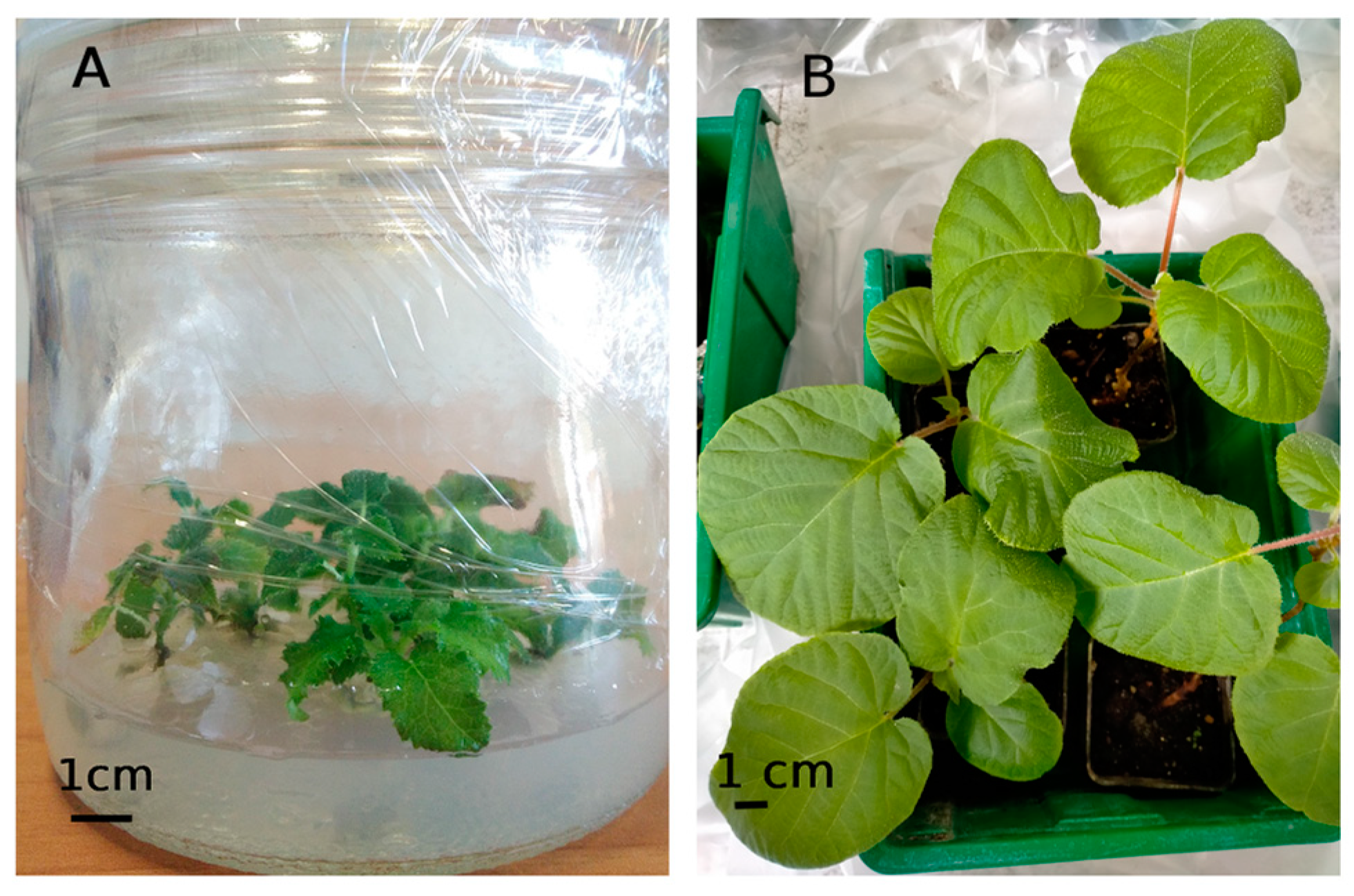
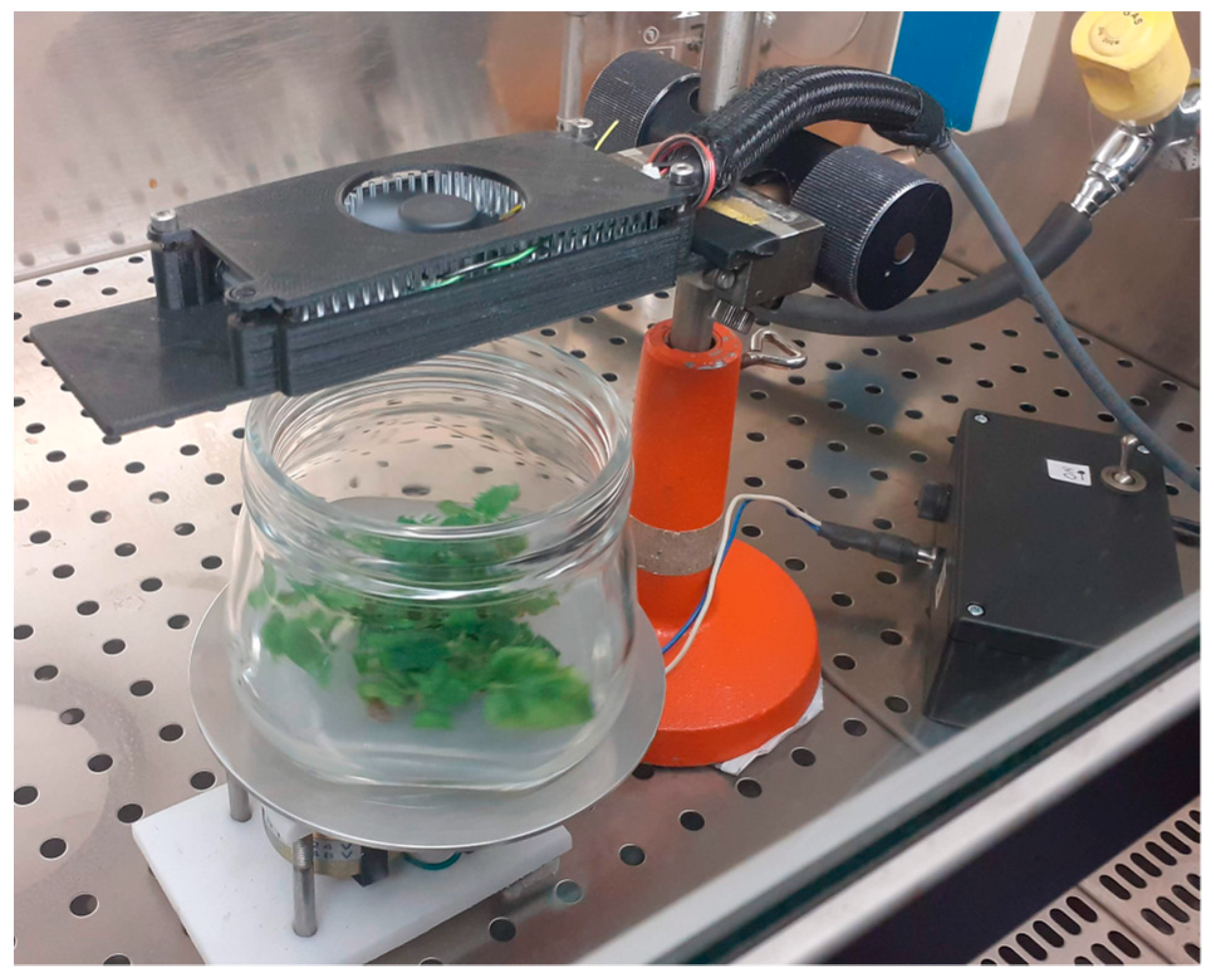
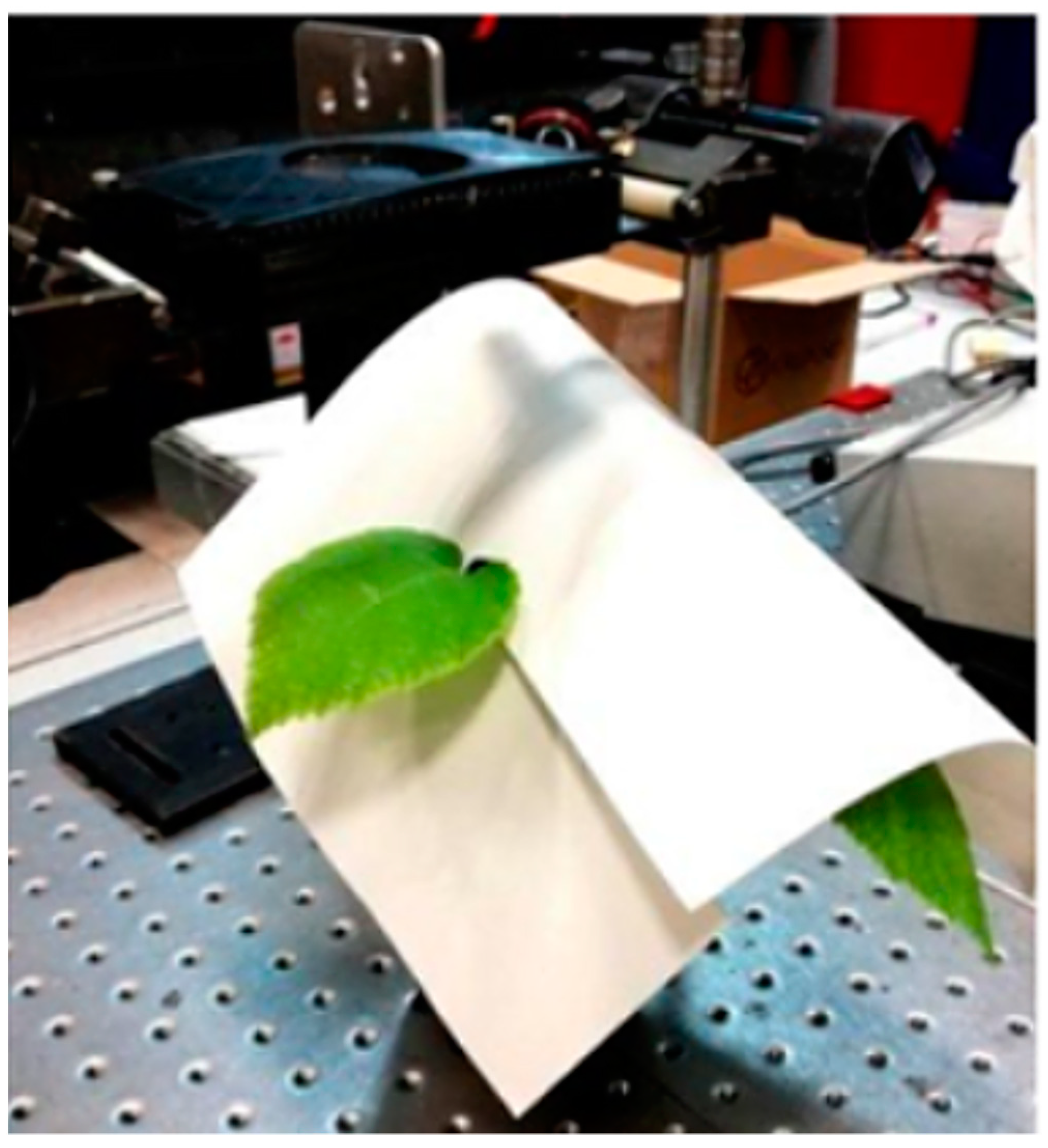
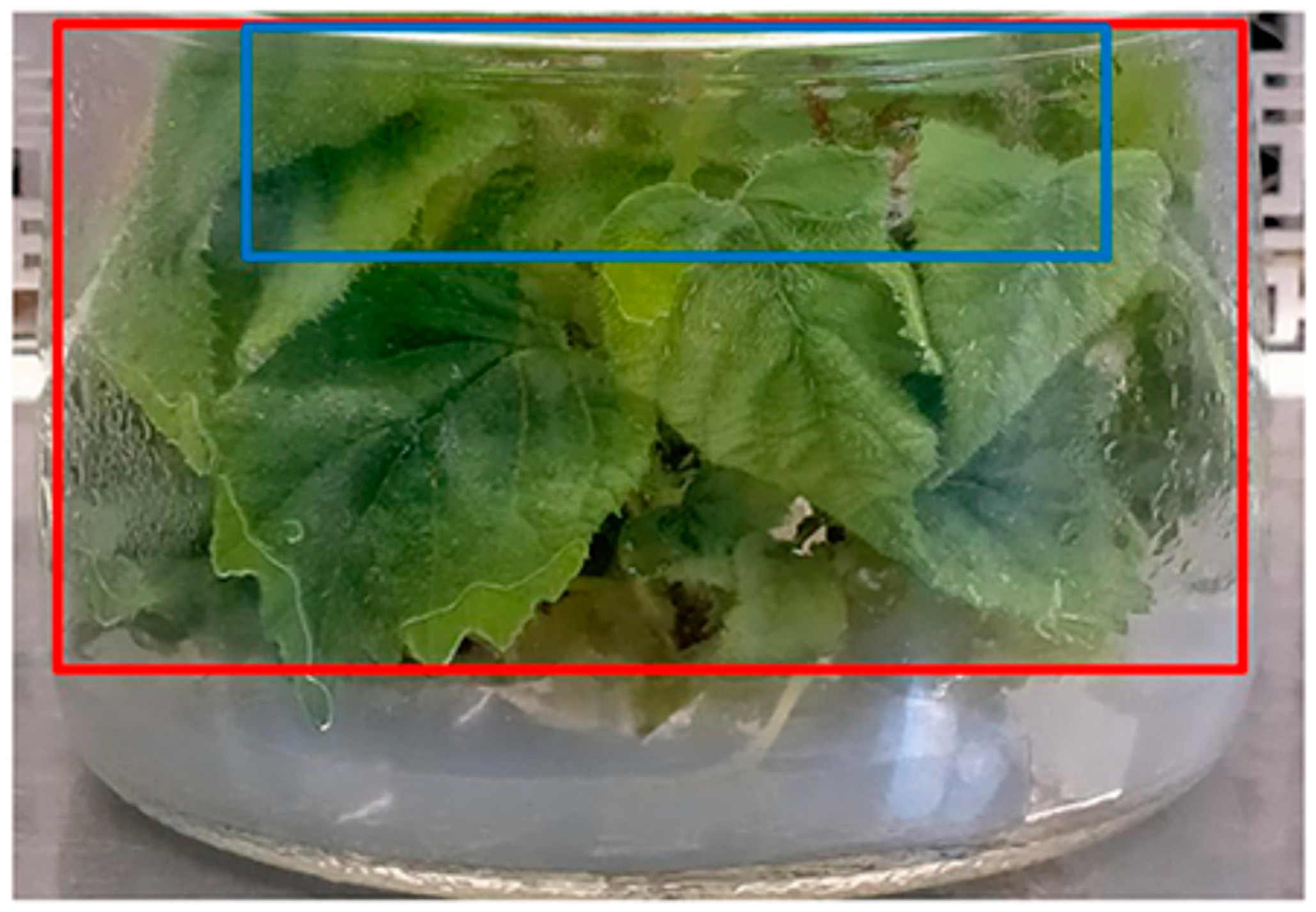
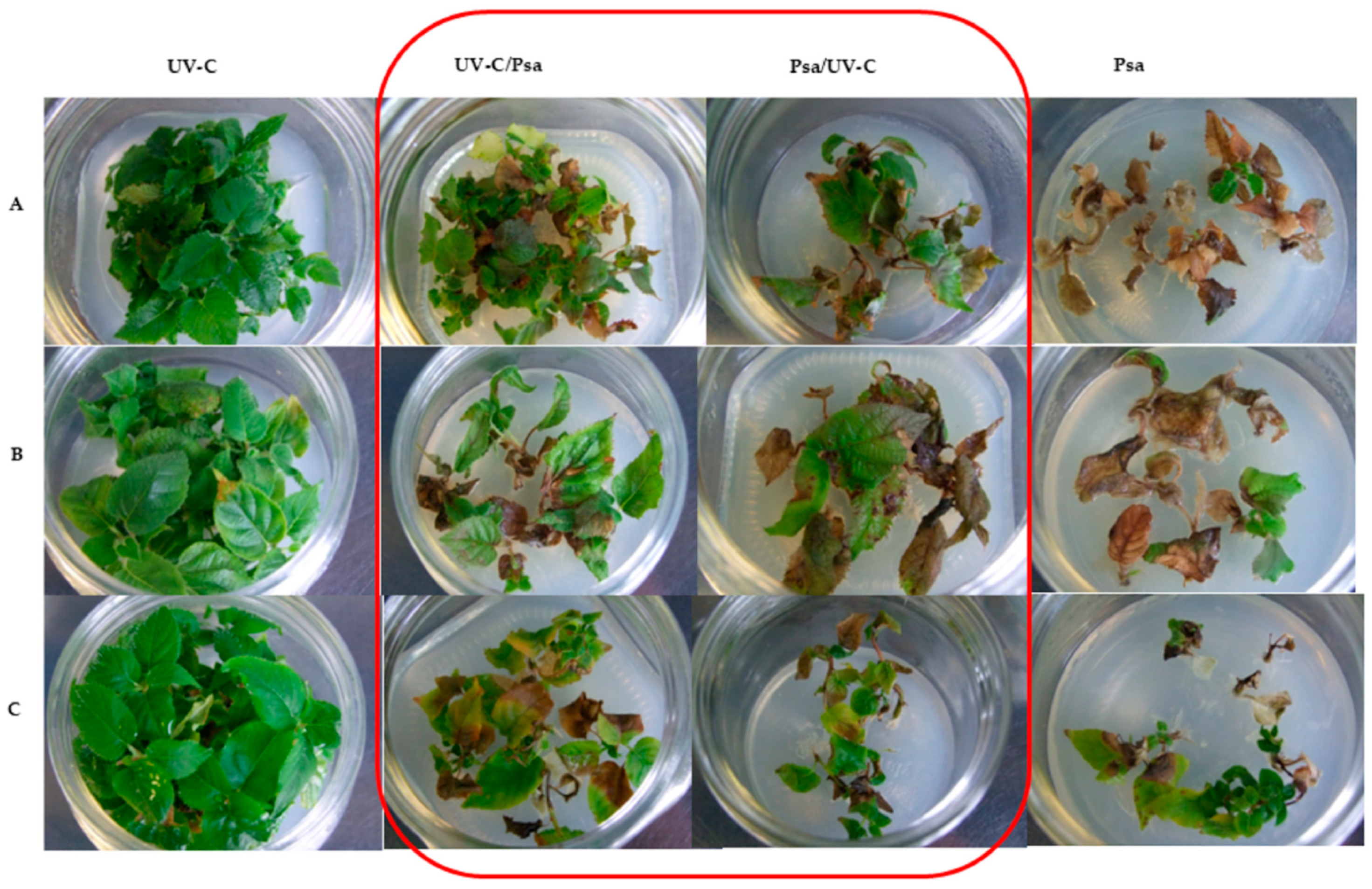
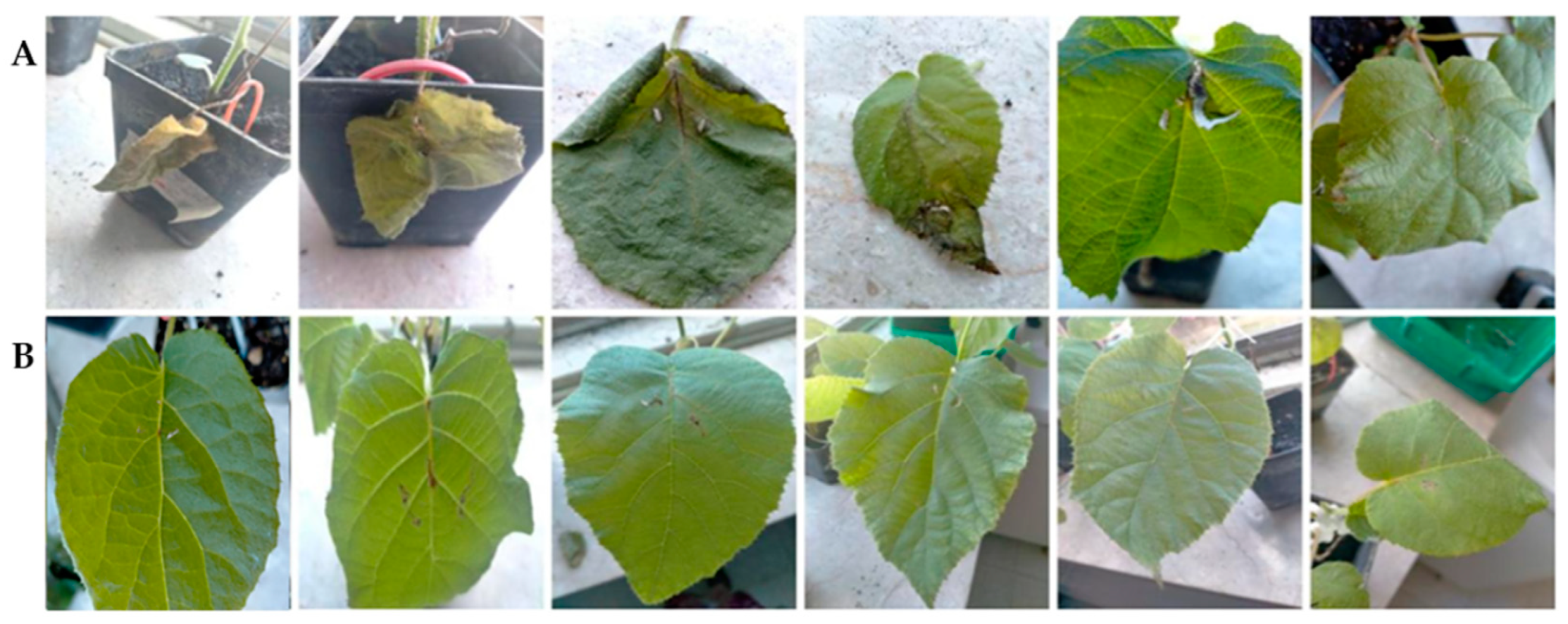
| Infection Scale (c) | Symptoms Detected on In Vitro Shoots | Symptoms Detected on Plant Leaves |
|---|---|---|
| 0 | Absence of symptoms | Absence of symptoms |
| 1 | ≤5% infected shoots | Very mild damage |
| 2 | 5–50% infected shoots | Mild damage |
| 3 | >50% infected shoots | Intermediate damage |
| 4 | 100% infected shoots | Severe infection |
| 5 | 100% dead shoots | Leaf abscission |
| MKI (%) | |||
|---|---|---|---|
| Treatment | cv. Soreli® | cv. Hayward | A. arguta |
| UV-C | 0 | 0 | 0 |
| UV-C/Psa | 38 | 58 | 42 |
| Psa/UV-C | 42 | 66 | 40 |
| Psa | 96 | 82 | 44 |
| Controls | 0 | 0 | 0 |
| Total Chlorophylls (ug/mg F.W.) | Total Carotenoids (ug/mg F.W.) | |||||
|---|---|---|---|---|---|---|
| Control Shoots, (Not Irradiated) | Partial Irradiation (Red Box) | Direct Irradiation (2.2 kJ/m2,(Blue Box) | Control Shoots (Not Irradiated) | Partial Irradiation (Red Box) | Direct Irradiation (2.2 kJ/m2, Blue Box) | |
| Genotype | ||||||
| Soreli | 4.79 a | 3.41 c | 4.20 b | 0.71 b | 0.61 c | 0.78 a |
| Hayward | 5.35 a | 4.04 b | 5.04 a | 0.53 b | 0.57 b | 0.79 a |
| A. arguta | 9.88 a | 7.68 c | 8.75 b | 1.59 b | 1.40 c | 1.89 a |
| TPC (ug GAEeq/mg F.W.) | AC (ug Trolox eq/mg F.W.) | |||||
|---|---|---|---|---|---|---|
| Control Shoots, (Not Irradiated) | Partial Irradiation (Red Box) | Direct Irradiation (2.2 kJ/m2, Blue Box) | Control Shoots (Not Irradiated) | Partial Irradiation (Red Box) | Direct Irradiation (2.2 kJ/m2, Blue Box) | |
| Genotype | ||||||
| Soreli | 34.4 c | 45.8 b | 54.3 a | 4.3 b | 6.6 a | 7.4 a |
| Hayward | 55.4 a | 33.5 b | 54.7 a | 3.0 c | 4.9 b | 7.4 a |
| A. arguta | 20.2 b | 21.5 b | 25.1 a | 1.0 b | 1.2 b | 1.5 a |
| Irradiated Dose (kJ/m2) | Chlorophylls a (ug/mg F.W.) | Chlorophylls b (ug/mg F.W) | Total Chlorophylls (ug/mg F.W) | Total Carotenoids (ug/mg F.W.) |
|---|---|---|---|---|
| 0.0 | 1.90 b | 0.77 b | 2.67 b | 0.70 b |
| 0.3 | 2.11 b | 0.77 b | 2.78 b | 0.81 b |
| 0.8 | 3.96 a | 1.50 a | 5.46 a | 1.39 a |
| 1.3 | 3.44 a | 1.27 a | 4.71 a | 1.19 a |
| Irradiated Dose (kJ/m2) | TPC (ug GAE/mg F.W.) | AC (ug Trolox eq/mg F.W.) |
|---|---|---|
| 0.0 | 34.38 c | 4.33 c |
| 0.3 | 33.96 c | 4.99 c |
| 0.8 | 34.88 b | 6.56 b |
| 1.3 | 38.63 a | 7.47 a |
Disclaimer/Publisher’s Note: The statements, opinions and data contained in all publications are solely those of the individual author(s) and contributor(s) and not of MDPI and/or the editor(s). MDPI and/or the editor(s) disclaim responsibility for any injury to people or property resulting from any ideas, methods, instructions or products referred to in the content. |
© 2024 by the authors. Licensee MDPI, Basel, Switzerland. This article is an open access article distributed under the terms and conditions of the Creative Commons Attribution (CC BY) license (https://creativecommons.org/licenses/by/4.0/).
Share and Cite
Lucioli, S.; Bollanti, S.; Murra, D.; Nota, P.; Scortichini, M.; Caboni, E.; Lai, A.; Bacchetta, L.; Di Lazzaro, P. Ultraviolet-C Light Effects in Actinidia spp. Infected by Pseudomonas syringae pv. actinidiae. Horticulturae 2024, 10, 944. https://doi.org/10.3390/horticulturae10090944
Lucioli S, Bollanti S, Murra D, Nota P, Scortichini M, Caboni E, Lai A, Bacchetta L, Di Lazzaro P. Ultraviolet-C Light Effects in Actinidia spp. Infected by Pseudomonas syringae pv. actinidiae. Horticulturae. 2024; 10(9):944. https://doi.org/10.3390/horticulturae10090944
Chicago/Turabian StyleLucioli, Simona, Sarah Bollanti, Daniele Murra, Paolo Nota, Marco Scortichini, Emilia Caboni, Antonia Lai, Loretta Bacchetta, and Paolo Di Lazzaro. 2024. "Ultraviolet-C Light Effects in Actinidia spp. Infected by Pseudomonas syringae pv. actinidiae" Horticulturae 10, no. 9: 944. https://doi.org/10.3390/horticulturae10090944








